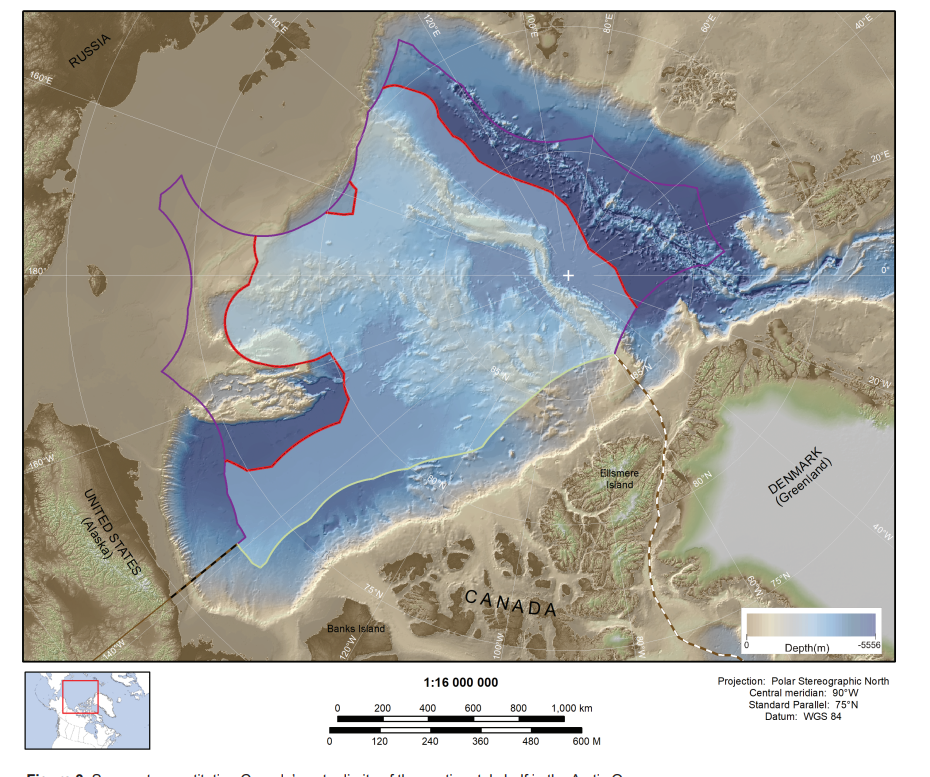Canada extends its Arctic Ocean seabed claim all the way to Russian waters
Consultations with Russia were held as Canada prepared its latest claim to the Arctic seabed, Ottawa says.

In an addendum filed on Monday, Canada substantially expanded its claim to the Arctic Ocean seabed. Canada’s claim now reaches in several places all the way to Russia’s exclusive economic zone.
The changes to the claim were delivered as a 54-page note, or addendum, to the UN’s Commission on the Limits of the Continental Shelf. The extension is now added to Canada’s original claim from May 2019.
Three accompanying maps show how Canada’s full claim now stretches along the length of the Lomonosov Ridge, a steep sub-sea mountain range to the west of the North Pole, to the limits of Russia’s exclusive economic zone 200 nautical miles from Russia’s coastline. A conservative estimate based on the three maps included indicates that Canada has extended its claim by some 600,000 to 700,000 square kilometers.
The Canadian claim is filed at a time when relations with Russia in the Arctic are severely strained because of Russia’s war on Ukraine. All collaboration with Russia within the Arctic Council, the main inter-governmental body in the Arctic region, is currently paused with no prospect of resuming soon.
Consultations with Russia
The original Canadian claim or submission from 2019 already overlapped with Russia’s claim to the seabed and also with a joint Greenlandic-Danish claim. The Canadian addendum filed with the CLCS on December 19 does not specify how large the overlaps are now, but the accompanying maps indicate that they have grown substantially.
The Canadian extension follows a claim by Denmark-Greenland from 2014 that stretches from Greenlandic waters to Russia’s exclusive economic zone and several extensions of Russia’s original claim from 2001. Russia has claimed in total some 75 percent of the seabed in the central parts of the Arctic Ocean — all according to regulations stipulated by the UN Convention of the Law of the Sea, which regulates the delineation of the seabed in international waters.
Claims to the CLCS may provide the claimant government with exclusive rights to exploit any resources on or under the seabed, but not any substantial privileges in the water column or above it.
Regular meetings between Canada, Russia and Denmark/Greenland at scientific as well as diplomatic level have been held to prevent any conflict, and Canada in its note of December 19 explains that “regular consultations” have been held with Russia during its preparation.
Some western analysts have worried that Russia, which planted in 2007 a much publicized flag on the bottom of the Arctic Ocean, might abandon its adherence to the UN Convention of the Law of the Sea, but no significant moves by Russia to do so have been publicly recorded.
The claims of the three nations will be evaluated by the CLCS’s international panel of experts. The CLCS will evaluate to what extent scientific data submitted by the three nations are sufficient to prove that their continental shelves extend into the Arctic Ocean to the degree their governments claim. The CLCS, however, is not mandated to decide on the final delineation of the seabed. According to the UN Convention of the Law of the Sea, the final delineation of the seabed — including that around the North Pole — should eventually be decided through negotiations among the nations involved.
The CLCS’s evaluation of the claims of all the three nations involved is expected to be finished only in a decade or more. An evaluation by the CLCS of Russia’s claims is expected in 2024, but due to a long queue of other claims from other parts of the world, an evaluation of the Danish-Greenlandic claim is expected only in eight to 10 years from now and an evaluation of Canada’s claim even later.
This article has been fact-checked by Arctic Today and Polar Research and Policy Initiative, with the support of the EMIF managed by the Calouste Gulbenkian Foundation.
Disclaimer: The sole responsibility for any content supported by the European Media and Information Fund lies with the author(s) and it may not necessarily reflect the positions of the EMIF and the Fund Partners, the Calouste Gulbenkian Foundation and the European University Institute.
